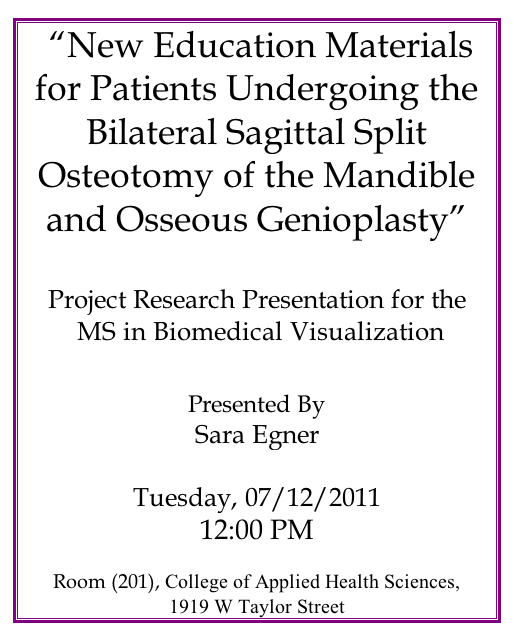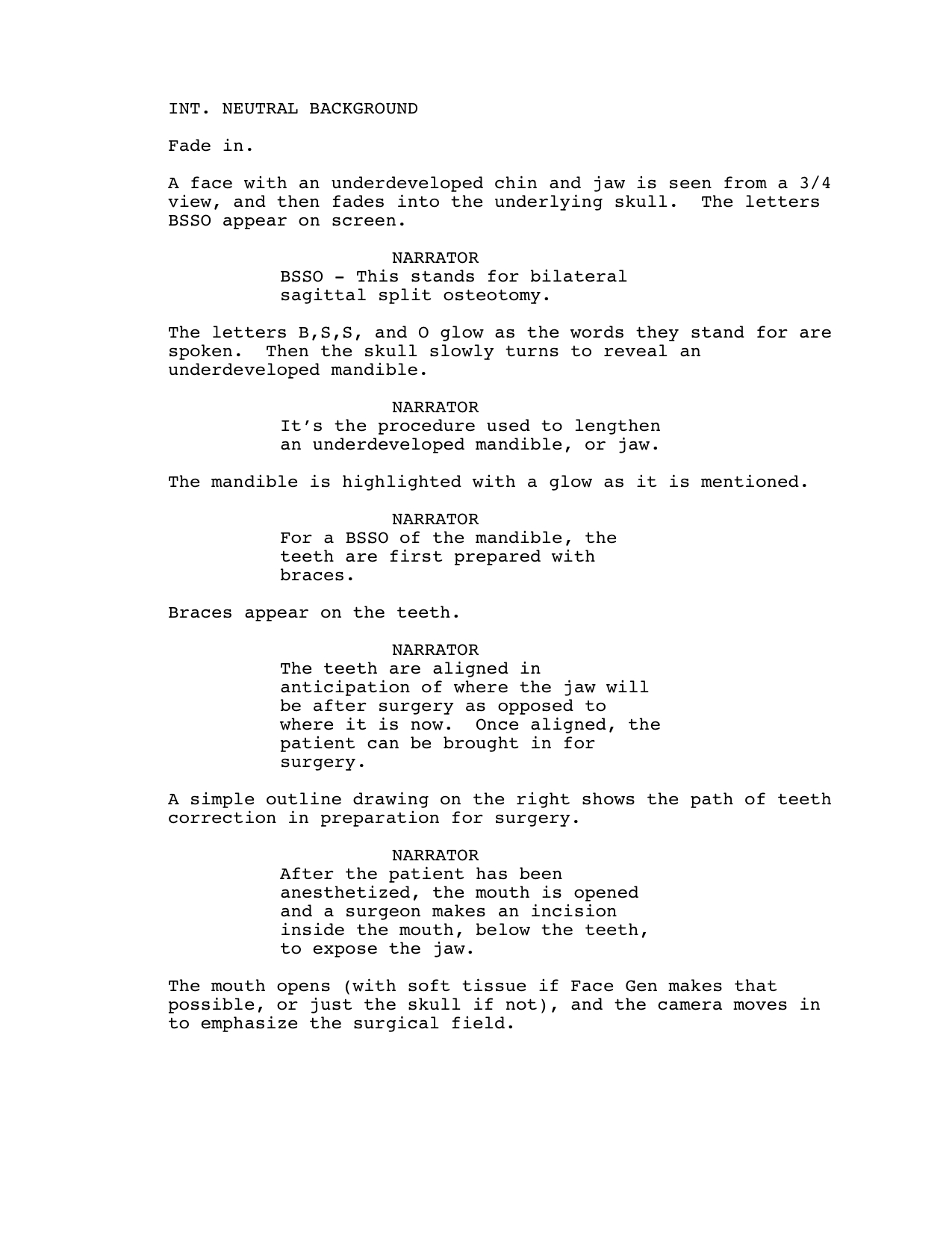Archive for the ‘patient education’ tag
Presenting Tomorrow…
Well, I guess that makes it official.
I am printing copies of the paper right now (sorry trees), and as soon as this is done I’ll see about printing slides from my presentation, and then making some good note cards for everything that I want to say. Wish me luck!
The Big Giant Paper
I realize that I haven’t been writing as much here lately. That’s mostly because I’ve been spending so much time working out the details of my my final paper for the upcoming defense of my masters degree. It’s looking like I am going to present just next week, and it is overwhelming how much there is to get in order. I’d like to post the whole paper here at some point, though I suppose I should look in to whether or not I’m going to submit it anywhere else before I go putting it up online. Here is the abstract though, for those of you interested in what I’m up to these days…
ABSTRACT
There is a need for education materials for patients undergoing orthognathic surgery. The problem of conveying intricate accurate anatomical information to patients presents a design challenge for creators of such educational materials. The goal of this project was to explore possibilities for using new advancements in 3D animation technology to improve understanding on the part of patients prior to surgery. Computed tomography (CT) scanning, surgical observation, 3D animation, editing software, and DVD authoring technologies were utilized in the creation of a 3D animation for patients preparing to under-go the bilateral sagittal split osteotomy of the mandible and osseous genioplasty surgical procedures.
Sitting at a current 29-32 pages (depending on whether or not you count the script that I’m including but haven’t placed yet), I believe this is by far the longest paper I’ve ever written. And that’s all I’m gonna say about that for now, as I need to get back to all that academic sayin’ that’s got to get done already!
The Bilateral Sagittal Split Osteotomy and Osseous Genioplasty
So, I was going to wait until I’d shown this in my big presentation next month, but I just couldn’t. I put it up tonight.
Introducing, The Bilateral Sagittal Split Osteotomy and Osseous Genioplasty…
And if that doesn’t work, here’s a direct link to the YouTube page itself – http://www.youtube.com/watch?v=oQI8L5Sxa6w
More Work On My Research Project Animation
Well, it’s been a working weekend, and most of that work has gone towards my animation on orthagnathic surgery. Yesterday I got my surgical plates and screws mostly together, though they could still use a few tweaks to get out the faceting, and there is one angle in the chin plate that I would still like to soften. But mostly, this is what I’m going for.
And then today I finished my re-write on the script. I’d still like to warn patients about the breathing tube and catheter, but it just doesn’t sink up with the animation visually or in terms of the type of information being given. I’m hoping that I will have time to create some kind of Know Before You Go page that can be included in the dvd, or even printed out and given to patients with the animation disk. Anyway, here is the script as it currently stands. I think it works.
Your Silicone Prosthesis and It’s Care
Sometime back, we were shown a brochure in the clinic entitled “Your Silicone Prosthesis and It’s Care.” It was clearly made a long time ago, and it was put forth that maybe someone would take on re-doing this brochure. I started to take on the project, but the scope of what was wanted changed, and it was decided to leave things as is for now. Since I’d already put in the effort of rewriting it I wanted to go ahead and share those words here. At some point I’d like to go ahead and finish with the design despite the change in plans at our own clinic and make it available as either a poster or downloadable brochure for anyone to use across any clinic. In the meantime, this is just the content, and perhaps some of you reading will have suggestions about how to make it better before I move into the design aspect.
**note – The title “Your Silicone Prosthesis and Its Care” comes directly from the original brochure.**
_____________________________________________________________________________________________________
Your Silicone Prosthesis and It’s Care
What is a silicone prosthesis?
A silicone prosthesis is a silicone replacement for a missing, underdeveloped, or disfigured body part. Silicone itself is an inert synthetic compound. It is used widely across a variety of industries including cookware, toys, and medicine. We use it in anaplastology because of it’s flexibility, durability, lightweightness, and capacity for color blending and translucency.
How long can I expect my prosthesis to last?
Wear and tear on a prosthesis is to be expected. Colors will change over time, silicone will tear, and the fit may even change, especially in growing children. In general, one can expect a silicone prosthesis to last one to three years. This estimate is of course greatly impacted by the environment to which the prosthesis is exposed.
Contributing factors
There are a number of contributing factors to how quickly a prosthesis will degrade. Sun exposure is one. As with most things, the sun can fade the coloring of your prosthesis. Outdoor wear in general can be a problem if you are in particularly dusty or grimy places. Smoke filled rooms are also problematic, as is smoking in general. Over time the smoke will stain the prosthesis. Around children or animals it is generally advised that you exercise caution in where you leave your prosthesis when you are not wearing it.
General Care
Attention to cleaning and storage (when you are not wearing it) of your prosthesis will help extend the amount of time between replacements. Your prosthesis should be taken off every night before bed and washed by hand with mild soap and warm water.. When not in use, store your prosthesis away from heat and sunlight. Avoid unnecessary handling, and airtight containers.
The Attachment Site
Whether your prosthesis is retained with adhesive, by implants, or anatomically, special care must be taken in cleaning the attachment site on the prosthesis as well as the skin around where the prosthesis sits.
An adhesive retained prosthesis requires careful removal of the adhesive from both the prosthesis and the supporting skin.
An implant-retained prosthesis requires careful cleaning around the metal of the prosthesis, and also the attachment site where it connects to you. A solution of saline and hydrogen peroxide is advised for cleaning the skin around protruding abutments.
An anatomically retained prosthesis simply requires general cleaning of both the prosthesis and skin.
Regardless of the type of attachment, you should always pay attention to the surrounding skin and report any changes to your doctor or anaplastologist. If you have any questions regarding proper care for your prosthesis please do not hesitate to ask your anaplastologist.
Preparing to Make an Animation
Today I was sent a link to a Portuguese medical animation company called Biosphera that has created an animation about the same procedure I have been studying lately. This one shows the bilateral sagittal split osteotomy of the mandible. I’ve linked to it here if you care to take a look.
http://www.biosphera.com.br/e-retrognathism.asp
In mine, I was planning to have less emphasis on the tools, more emphasis on the artery and nerve, and I also intend to include an osseous genioplasty procedure because the two are often done together in the same surgery. For those of you reading this who don’t speak medical jargon, I’m basically talking about a surgery that lengthens the jaw, bringing the lower teeth forward, and then in a second procedure to bring out the chin. I’m looking to do this as a take home DVD for patients and their families prior to surgery.
I have to admit to being a little disappointed to realize that there are already other animations out here on this topic. When I’d started this process I was under the impression that there just weren’t any. But at the same time, it’s always fun to see how other people have handled the same topics. Here is another one I found on YouTube that covers a different facial adjustment procedure but includes the osseous genioplasty.
http://www.youtube.com/watch?v=8h0wG1rKPSY
All in all, I’m glad that I didn’t find these other examples earlier. This way I’ve had more time to think about my own solutions to presenting the information in the most accessible way possible. For instance, my version is already scripted to include narration, and I’m happy with that choice. I’m actually hoping to translate that narration into Spanish as well for more widely accessible final DVD. I’ve been getting some advice against attempting the dual-language feature this week, but I have to say, I’ve been really attached to the idea ever since thinking of it. Everywhere I’ve ever lived has had a significant Spanish speaking population, and while I’ve never truly been fluent myself, it just feels right to make the effort for this.
Well, I’m sure I’ll be writing more about this later. There is just so much to think about when making decisions about the level of detail to include for patients, finding the right level between showing something gory and showing something completely whitewashed, emphasizing risk without being too scary, emphasizing the benefits of surgery without implying a guarantee, and then there’s just making it all look good. You’re all in it with me now, readers. Let’s make an animation!
animation – the possibilities
Last week, I posted my very first animation. It was created using 3dsMax, and then I added some sound in Final Cut Pro afterwards. It was pretty cool figuring out how to make all those little objects move around and interact with one another.
I’ve been thinking a lot about animation lately. Just last week I spoke with a surgeon who is interested in creating patient education animations to give to his patients prior to surgery. This has me thinking a lot about what is possible there, and what is appropriate. There is a website, Understand.com that specializes in doing this kind of thing. Some of their pieces I like better than others. It’s nice having some time to think about what I feel is important to a patient education video, and to talk to previous patients of various procedures about the kinds of things that they understood going into surgery, and what they wished they’d understood afterwards. If anyone reading has any thoughts and/or personal experiences to this end, I ask you to please comment with your thoughts.





